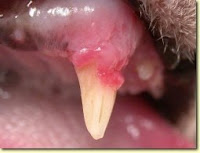 When your dog gives you kisses do you almost pass out from the stench of her breath?
When your dog gives you kisses do you almost pass out from the stench of her breath?Dental disease is one of the most common disorders diagnosed on wellness exams. It is estimated that 80% of dogs and 70% of cats over the age of 3 year old suffer from some degree of periodontal disease.
While a dental cleaning results in whiter teeth and fresh breath, the main benefit is to your pet’s overall health. Consider this: every time your pet chews bacteria is showered into the bloodstream. This then lodges in the kidneys, liver, lungs and heart causing damage and disease. In addition, open fractures, feline odontoclastic resorptive lesions, tooth root abscesses and worn teeth are painful and can act as a constant source of discomfort for your pet.

Rather than wait for a problem to develop, it is best to perform a dental cleaning when only mild gingivitis and/or tartar are present. This will maintain good dental health and prevent disease before it becomes a problem, which results in saving you money and more importantly keeping your pet as healthy as possible.
I realize a dental cleaning is not only expensive but it can be scary to put your pet under anesthesia. While anesthesia is daunting, at Friendship we do everything we can to make it as safe as possible with aggressive monitoring while your pet is under anesthesia. At Friendship we are convinced that the low risk of anesthetic complications is far outweighed by the benefits of good dental health. After continuously seeing the many complications that can arise from poor dental health I have regular dental cleanings done on all my dogs, the cats don’t need it quite yet. After your dental cleaning we will work with you to keep your pets teeth healthy and prevent tartar buildup. Schedule a dental cleaning and start enjoying those doggie kisses again.











